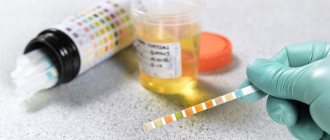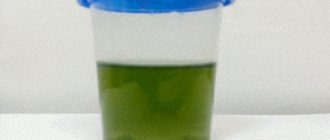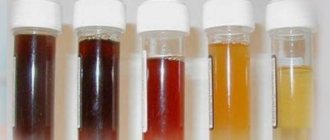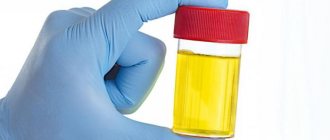The kidneys are the body's filtering system. During the purification process, remnants of medicinal substances, decay products, toxins and salts unnecessary for the body are isolated from the bloodstream. Subsequently, all the “garbage” is excreted in the urine. The listed list of released substances can change the color and other laboratory parameters of urine.
You should know that the color criteria are also influenced by the colored foods consumed. The most common product that is prone to staining urine is beets. Approximately 60-70% of people noted the appearance of red or pink urine after eating this root vegetable. Natural questions arise: why does urine change color after eating beets? Is it normal when urine takes on its usual shade?
Reasons: Why may urine be reddish or pink after eating a vegetable?
It is considered natural that the urine turns reddish after eating food containing beets. This is completely normal and should not be a cause for concern. This happens due to the fact that the breakdown of pigment in the body under the influence of gastric juice does not occur; it is absorbed in the intestines. The color of urine normally ranges from light pink to red. Feces can also take on a reddish tint.
Urine after beets is not colored every time. There are several factors that influence this. The color change depends on:
- method of preparing the dish (when boiling, part of the pigment goes into water; when baking or steaming, all components remain in the vegetable);
- time and method of storing beets (the longer the root crop lies in the sun, the less betanin it contains);
- varieties of beets (each of them has a different amount of betanin; in general, cylindrical root vegetables contain less pigment than spherical ones);
- the level of acidity of gastric juice (the higher it is, the richer the color of the urine after eating the root vegetable).
Changes in the color of urine due to eating root vegetables occur in both adults and children, regardless of age. This effect wears off over time. Usually, after just a few acts of urination or defecation, urine and feces acquire a natural color.
Let's consider why after a meal during which beets were consumed, the urine may be red. There are also conditions under which the staining of urine with beetroot betacyanins may be more pronounced:
- Dysbacteriosis.
With dysbiosis, an imbalance of the natural microflora of the gastrointestinal tract occurs. As a result, the ability of the gastrointestinal tract to absorb substances changes. As a result, the breakdown processes occur more slowly and most of the “waste” begins to enter the kidneys, where at the physiological level it cannot be completely processed. Then betacyanins are found in the urine.The solution is to include probiotics in the diet - products that have a positive effect on the proliferation of microflora.
- Imbalance of urine acidity.
During normal functioning of the urinary system, the pigment from beets is still present in it after consumption. In this case, discoloration occurs due to the slight acidity of the urine itself.
The vegetable also turns the urine red if any medications that increase acidity were taken along with the beets. - Kidney problems.
All useful and unhealthy substances pass through the kidneys, like through a sponge. If the “sponge” stops filtering when a malfunction occurs, then the “waste” will be output without change. Beet pigments are also classified as “waste”. - Gynecological problems in women.
Can women get stained and why? In case of gynecological diseases, it is not the dye that gets into the urine, but blood. As a result, women's urine also turns reddish and pink.
Change in urine color after eating beets may indicate illness
You may have noticed that after eating beets, the color of your urine or stool became darker: red or pink. This phenomenon is called bituria and it may indicate certain diseases.
According to studies, this condition occurs in 14 percent of the population, Healthline reports, citing The Lancet.
The main symptom of bituria is a change in the color of urine or stool - they may appear red or pink after eating beets or juices that contain extracts or pigments of this vegetable.
The degree of discoloration varies depending on the specific beets you consumed. For example, raw beets may cause urine to be dark red or dark pink, while cooked beets may cause urine to be light pink or light red.
The color change is due to the food coloring betanin found in beets. When it enters the body, it ends up in the kidneys, thereby causing the urine to change color.
Red urine after beets may be a symptom of anemia or stomach acid deficiency
When color is a sign of pathology
But it is not always beets that turn urine red. If you blame everything on the product, then you can miss serious violations in a woman’s body. This symptom has several diseases. All of them require mandatory treatment.
| illness | description |
| Blood impurities | This phenomenon occurs for various reasons. The most harmless is menstrual blood. It is impossible to get rid of it. It is not a problem and does not require mandatory treatment. The second option is hematuria. |
| Inflammatory process of the urinary tract | Accompanied by pain or discomfort. Blood may already be in the urine right away, or it may appear at the last moment. It is not necessary that the color be bright red, varying from pale pink to black and red is allowed. |
| Cystitis, kidney stones | You can independently determine the disease based on the symptoms that accompany all bowel movements. But for a more accurate diagnosis, you should go to the hospital |
| Gynecological diseases | The inflammatory process occurring in the reproductive system also has a symptom of stained urine. The most dangerous of them is cancer |
| Taking medications | Quite often, laxatives or diuretics have this side effect. You can only check by completely refusing to accept |
But in any case, a vital question arises: is red urine normal after beets? Quite. The fruit contains a special pigment, which causes coloring. In this case, it does not matter at all in what form the product entered the body: boiled or raw. But in any case, you should visit a doctor to check for dysbacteriosis, blood sugar and iron levels, as well as kidney pathologies.
Diagnostic measures
By regularly monitoring your urine (its color, consistency, smell and other characteristics), you can notice the occurrence of various diseases at an early stage and begin treatment. That is why you should not neglect such a simple and accessible method of diagnosing the condition of the body.
In addition to visual tracking, there is one method that allows you to examine urine, or rather, determine the approximate cause of the change in color and understand whether it was colored due to the presence of blood or whether it was due to the influence of red pigments from consumed beets.
To conduct your own research, you will need baking soda, vinegar, and a collected sample of colored urine. To begin, add a small amount of baking soda to the discharge sample, after which a drop of table vinegar is added to it.
If after adding soda the unnatural color of urine disappeared, and after adding vinegar essence it appeared again, then you don’t have to worry - the red color of the urine was not due to blood getting into it, but changed under the influence of the product eaten.
Unfortunately, such a test does not have great reliability of the results obtained, therefore, if some problems arise in the functioning of internal organs and the urine turns red after eating beets, it is strongly recommended to consult a doctor.
In addition to the reasons for the coloring of urine, some are interested in how many days the unnatural color of the discharge can remain if beetroot juice has been consumed. Experts answer that this requires 1-2 days.
Home experience to determine the cause of urine coloring
Concern should arise when the urine turns red, regardless of the consumption of coloring foods. The cause of this phenomenon could be some kind of disease if, along with a change in color, there are other symptoms:
- discomfort, pain in the lower abdomen;
- sharp, unpleasant odor of urine;
- pain and burning when urinating;
- increased body temperature;
- frequent urge to urinate;
- loss of strength, drowsiness.
If you notice one or more symptoms, you should immediately consult a doctor. They may be signs of the presence of various diseases of the genitourinary system:
- inflammatory processes in the kidneys;
- urolithiasis;
- injuries or tumors of the urinary system;
- endometriosis in women;
- prostatitis in men.
The fact is that even in the absence of any problems in the functioning of the urinary system, some of the pigments contained in beet juice are also present in the urine. But normally, its acidity contributes to their discoloration.
If you consume beets together with foods or medications that increase the acid balance of urine, then pigment compounds will be visible in the form of coloration.
With such a reaction, which is repeated quite often, it is necessary to evaluate the result of a general urine test and possibly change the daily diet to reduce the acid balance.
Acidity analysis is carried out quite quickly and can be carried out in any laboratory
Dysbacteriosis
Another possible reason for a change in urine color may be an imbalance of microorganisms in the intestines (dysbacteriosis). At the same time, the absorption function of the gastrointestinal tract changes (the breakdown processes slow down much) and most of the breakdown and processing products begin to enter the kidneys, where they physically cannot be completely processed.
Then betacyanins (coloring substances) from beets are present in the urine. In this situation, you need to include in your diet foods that have a beneficial effect on the proliferation of intestinal microflora (fermented milk products, vegetables and fruits). Among the medications, Acylact, Probifor, Bifidumbacterin, Florin, etc. can be prescribed.
Kidney problems
Impaired filtering function of the kidneys due to inflammatory and other pathological processes can also be the reason why the urine is colored. In this case, the kidneys eliminate decay products almost without processing. If this is precisely the cause of the residual content of pigments in the urine, then you need to consult a doctor to conduct a more detailed examination.
All causes of changes in the color of urine from food and in particular from beets require consultation with a doctor and a series of diagnostic procedures (urinalysis, ultrasound of the kidneys, etc.). But in most cases, adjustments to your diet and lifestyle are usually sufficient.
Sometimes eating beets coincides with the appearance of red urine for other reasons.
Blood in the urine is usually accompanied by additional symptoms
The production of such urine is considered to be particularly dangerous if the following is additionally observed:
- noticeable cloudiness of urine;
- any unpleasant sensations (pain, burning, stinging) before, during or after urination;
- pain in the bladder area (behind the pubic bone) or in the kidney area;
- symptoms of intoxication (chills, headache, fever, etc.);
- delay or decrease in daily urine volume.
What diseases are associated with low specific gravity of urine?
In this case, most likely, there is a disease of the urinary organs (cystitis, glomerulonephritis, pyelonephritis, kidney stones, etc.).
In a woman, red or pink urine can be caused by various gynecological diseases. In this case, blood from the vaginal cavity can enter the urine, coloring it. Therefore, in addition to contacting a therapist or urologist, women may need the help of a gynecologist.
In men, pink or reddish urine appears mainly due to inflammation or the presence of a tumor in the prostate gland.
The discharge of red or brown urine in the presence of pathologies is caused by the appearance of red blood cells (blood cells) in it.
Blood in the urine is a reason to urgently seek medical help.
When taking certain medications (laxatives, blood thinners, etc.), urine can also change color, including red.
It is known that the change in color of discharge is affected not by the beets themselves, but by their juice. Most often, beet juice is taken as a health remedy that has a beneficial effect on the functionality of the body.
But there is still no consensus whether the urine from beets can be red due to the pigments in the vegetable, or whether the reason for this phenomenon lies elsewhere. Today, there are several main opinions that try to explain the change in color due to consumption of the vegetable:
- Some argue that redness of urine after eating beets clearly indicates that there are disturbances in the functioning of internal organs in the body, namely the kidneys. Therefore, if a change in color is detected, you should consult a doctor as soon as possible to prescribe the correct treatment.
- Opponents generally believe that urine may be red from beets due to dysbacteriosis. Eating a vegetable when the balance of the microflora changes makes itself felt in the form of redness of the discharge, while in a healthy person the color of the urine will not change.
- It is also believed that the red color of urine after eating indicates that a person has iron deficiency anemia. With a reduced number of red blood cells and/or hemoglobin levels, consumption of beets can lead to significant coloration of urine, which will indicate the presence of pathology.
- Another side refers to the fact that no doctor will make a correct diagnosis without preliminary tests and diagnostics. Red urine after eating beets may indicate kidney problems, but this condition is not necessary for every person. Some people may experience changes in the color of their urine without having a medical condition.
While there are various theories explaining the reason why the color of urine changes after eating beets, many experts claim that often even people who do not complain of kidney problems and who have undergone a course of medical therapy note a normalization of the color of their urine even after eating the vegetable.
Therefore, if you observe staining of urine, you should consult a doctor about diagnosing infectious kidney diseases.
The lilac (red-violet) color of beets is due to the presence of betalain pigments. The vegetable contains both red (betacyanins) and yellow (betaxanthins) varieties of coloring matter, but the amount of the latter is insignificant.
Among the compounds of the betacyanin group, betanin plays the main role in coloring. The useful natural food coloring E-162 (beetroot red) is synthesized from it. The latter, by the way, is labeled as doubtful only because of the possibility of chemical modification or the addition of nitrates when growing beets.
When entering the human body, especially in large quantities and in its raw form, betanin must be completely broken down in the stomach. However, if this does not happen (perhaps due to the pH level of the gastric juice), it ends up in the intestines, where it is absorbed into the blood.
The substance then travels through the bloodstream to the kidneys, where it is filtered and excreted in urine.
It is a popular statement that the anthocyanins contained in beets are responsible for the color of urine. This is not true: anthocyanins in the vegetable are present in small quantities, insufficient to create such an effect.
Ultimately, you can understand that the coloring of urine in red shades is a completely natural process in the body after eating beets.
The red color of urine is not always caused by physiological factors. Sometimes it takes on this shade, signaling problems in the body and serious diseases that require treatment:
- Bleeding of the genitourinary system;
- Taking medications - for example, propofol, some painkillers and diuretics;
- Poisoning and intoxication of the body with mercury or lead;
- Inflammation of the bladder - it can be recognized by noticing shapeless blood clots in the fluid;
- Bleeding in the kidney - it is indicated by worm-like clots;
- Infectious diseases of the urinary tract;
- The presence of red blood cells in the liquid, which indicates the presence of an inflammatory process;
- Stones in the kidneys;
- Blood clotting disorders;
- Injuries in the lumbar region;
- Glomerulonephritis;
- The presence of salts, which may be a consequence of urolithiasis, gout;
- Oncological diseases.
Urine can also change color under the influence of:
- Age. For example, in men over 50 years old, blood tests show adenoma;
- Paula. In women, this phenomenon is provoked by infectious diseases;
- Viral or bacterial infections;
- The presence of kidney diseases in close relatives;
- Strong physical activity.
The problem can be eliminated only by curing the underlying disease.
There is a simple experiment that anyone can do at home. It allows you to determine why the urine is red - there is blood in it or it is beet pigments. To carry it out, you only need baking soda and 9% vinegar. A teaspoon of soda is added to 50 ml of urine, and then a tablespoon of vinegar is poured.
Treatment
Iron deficiency is sometimes caused by internal bleeding in the pelvic organs. This can be determined using ultrasound or endoscopy. When bleeding is diagnosed, surgical treatment is often required.
If iron deficiency is not associated with this, it is enough to carry out therapy with vitamins and drugs that increase hemoglobin in the blood. But if there is no result from the diet, the doctor prescribes products that contain iron: “Hemohelper” with “Actiferrin”, “Fenuls” with “Ferlatum”, etc. .
In case of dysbacteriosis, foods that have a beneficial effect on the intestinal flora are introduced into the menu (fermented milk, vegetable dishes, fruits). If the effect is weak, the doctor prescribes “Acilact”, “Bifidumbacterin” for children, etc.
If your stomach acid level is low, there are several options to increase it:
- Chew food thoroughly and take small pieces. This stimulates all digestive enzymes.
- Follow a diet, eating more dishes from fresh vegetables, fruit salads and juices. Limit sweets, baked goods, processed foods and alcohol. Among the vegetables, pickled cucumbers or cabbage must be present. These foods increase acidity.
- Food must be eaten in small portions.
Treatment of infection of the renal system involves a full course in combination with aseptic and antibacterial medications. In this case, medications such as Urolesan with Phytolysin or Furagin, etc. are used.
So, if, as a result of eating beet, the urinary fluid turns pink or reddish, this can often be far from harmless. Therefore, if you have doubts, you need to quickly visit the clinic and undergo an examination.
There are no specific and standard treatment measures - it all depends on the reasons that provoked the problem. If beets are to blame, you don’t need to take any medicine, just wait and the normal color of the liquid will return.
True, some doctors may prescribe additional tests:
- General urine analysis - it can be used to determine the presence of an inflammatory or infectious process in organs, and other abnormalities;
- Blood test - general and biochemical;
- Other laboratory tests.
If the reason is physical activity, it is enough to reduce it, and if it is due to a lack of hemoglobin, you should start taking iron supplements.
Can there be pink urine after eating beets? Yes, this is quite possible, but you need to pay attention to the consistency of the liquid and the duration of this phenomenon so as not to miss the pathology.
If, after eating beets while visiting the restroom, you notice that your urine has turned red, you should not self-medicate or take any medications without the prior approval of your doctor.
First of all, the specialist prescribes a set of diagnostic measures aimed at identifying the reasons why the urine could be colored, and, depending on the disease, prescribes competent treatment. In this case it will be necessary:
- Take a general urine test. It is necessary to detect inflammatory or infectious diseases in internal organs and other pathologies.
- Take general and biochemical blood tests to determine the level of hemoglobin and the number of red blood cells per unit of blood.
- Perform an ultrasound examination of the abdominal organs if you suspect diseases of the kidneys and/or urinary system.
- Undergo other laboratory and diagnostic tests.
If, based on the results of the diagnostics, it is revealed that after eating beets, the urine is red due to a lack of hemoglobin, i.e. Iron deficiency anemia has been diagnosed, in which case the doctor recommends taking iron supplements, which include: Actiferrin, Hemohelper, Ferlatum, Fenyuls.
Most often, to treat the cause of changes in the color of urine in the form of infectious kidney diseases, complex therapy is used, consisting of a course of antibacterial and anti-inflammatory drugs. The patient is prescribed the following medications:
- Urolesan. The product is intended for the treatment of infectious diseases of the kidneys and the removal of stones from them, while it has an anti-inflammatory and analgesic effect. Most often prescribed for the treatment of pyelonephritis, cystitis, and urolithiasis. Contains mainly natural ingredients: essential oils and extracts of medicinal herbs.
- Phytolysin. The action of the drug is based on its bactericidal, diuretic and analgesic properties. The product is available in the form of a paste for oral use, which contains components of natural origin. Diseases for which the use of the drug is recommended include pyelonephritis in acute and chronic forms, and urolithiasis. In this case, a contraindication for taking this drug is the presence of glomerulonephritis, nephrosis and renal failure in the patient.
- Furagin. In addition to antimicrobial and antibacterial effects, the drug is able to activate the immune system, helping the body cope with the infection on its own. The drug is recommended for the treatment of acute and chronic diseases of the urinary system, but is strictly contraindicated for infectious diseases of the renal parenchyma.
It must be remembered that if the urine changes its color to red after consuming beets, this is not always a consequence of an infectious disease in the kidneys. Therefore, before using any of the above drugs, it is necessary to consult with a specialist about the need to prescribe treatment, having previously passed the necessary tests and undergone additional diagnostics.
Moreover, after evenly distributing effort on the exercises, the discharge after beets acquires its natural shade.
Analyzes
If you have any doubts about the change in color of the discharge, you need to consult a doctor and undergo a series of tests. A stool test will help determine the presence of blood. You just need to remember that a few days before the analysis you need to exclude coloring foods from your diet.
If the color of urine lasts more than 2 days after eating beets, then you need to undergo a general clinical analysis of urine. If necessary, the doctor will refer you for a Nechiporenko test. This urine test accurately determines the number of red blood cells.
If you suspect kidney disease, you should also undergo ultrasound diagnostics. This will help to examine changes in the excretory organs and determine the cause of bleeding.
Does it change equally or not in children and adults - what is the difference?
Beets are famous for their beneficial effects on the functioning of the intestines and the entire body as a whole.
For young children, this vegetable is mainly given in the form of boiled puree.
In its raw form or in the form of freshly squeezed juice, only adults can consume the root vegetable to avoid negative effects on the baby’s gastrointestinal tract. However, the presence of even boiled beets in a child’s diet is welcome.
But a child’s body is somewhat different from an adult’s, so for many children, eating beets affects not only the color of stool, but also the color of urine. Seeing that the child’s urine has acquired a pink or reddish tint after eating beets, most parents panic. Although the systems of the child’s body are not yet fully formed (many of them continue to form until the age of 14-16), and it is for this reason that pigments from beet juice can be massively excreted along with urine, which is why urine is colored.
But in the case of a child, it is still better to play it safe and if you see urine with a reddish tint, be sure to contact a pediatrician or pediatric urologist. The doctor will first prescribe a general urine test, which in this situation will be one of the most accessible and informative diagnostic measures.
Can a child develop color, does this happen?
Beets are useful not only for adults, but also for children. It has a good effect on the functioning of the gastrointestinal tract. This vegetable is given to young children after heat treatment and in the form of puree.
It is not recommended to give raw beet juice to children. It can cause irritation of the gastrointestinal tract, but boiled, on the contrary, promotes good peristalsis.
Can a root vegetable stain an adult's urine? For adults, the raw product is absolutely safe. A child's body is different from an adult's. In children, urine staining occurs in almost one hundred percent of cases. A child's filtration system continues to develop with age, so it is not perfect in the early stages. That is why pigments are excreted from the child’s body unchanged.
Urine is intensely colored. Parents need to know that if a child has a change in the color of urine, then contacting a doctor should be mandatory.
How long does the color last?
Red stool after eating beetroot is associated with the action of the pigment betanin. This substance is not always completely destroyed by gastric juice. For example, with low acidity in humans, it is excreted from the body through the kidneys and intestines practically unchanged.
Raw beet recipes are considered the most healthy. But it is precisely such dishes (for example, salads) that most often cause a change in the color of the stool. However, red feces after beets can also appear as a result of eating borscht or vinaigrette.
However, it is not only red beets that can affect the color of feces. Betanine is used in many other products as a coloring agent, E-162 (beetroot red). In this form, it can also affect the color of stool.
After eating beets, red urine may be observed for 2 days. The color of stool lasts about the same amount of time. During this time, betanin is removed from the body.
If, after beets, red feces and urine persist for a longer period, then most likely this manifestation is not related to food. If a person’s health worsens, this should be a reason to consult a doctor.
Traditional medicine recipes
As mentioned above, the red color of urine after eating beets does not always signal problems in the functioning of internal organs, in particular the kidneys. But to prevent color changes after eating a vegetable, traditional therapy suggests following some recommendations:
- Visit baths or saunas as often and regularly as possible, but only if this is not contraindicated for other existing diseases. At the same time, steam procedures using essential oils from coniferous trees, which have anti-inflammatory and antibacterial effects, are most effective. After warming up the body, manual massage in the back and buttocks is very useful.
- Avoid hypothermia. Therefore, you should avoid dousing yourself with cold water, swimming in pools, and rubbing yourself with snow.
- It is recommended to regularly drink teas with the addition of raspberry, linden, honey or sage, which have a wonderful diaphoretic effect.
While following the rules of traditional medicine, you should not neglect traditional therapy, especially if pink or red urine after eating beets has been bothering you for a long time.
Laxative effect
Often, after eating beetroot dishes, red, liquid stools may occur. This manifestation usually frightens a person, because it is very reminiscent of diarrhea with blood, which can be a sign of dangerous diseases.
However, there is no need to worry ahead of time. It must be remembered that this vegetable has laxative properties. This is also due to the chemical composition of beets. The product is rich in fiber, which activates the intestines and enhances peristalsis.
For this reason, doctors do not recommend consuming this vegetable if you are prone to diarrhea. But it can be very useful if you have difficulty bowel movements. Experts recommend a recipe made from beets with sunflower oil as a folk remedy for constipation.
However, even people who do not suffer from diarrhea should eat this vegetable in moderation. Eating beetroot dishes in large quantities can lead to intestinal upset.











